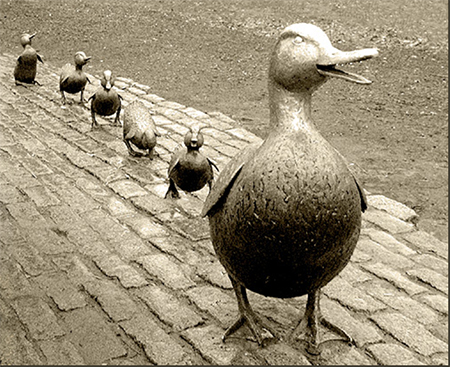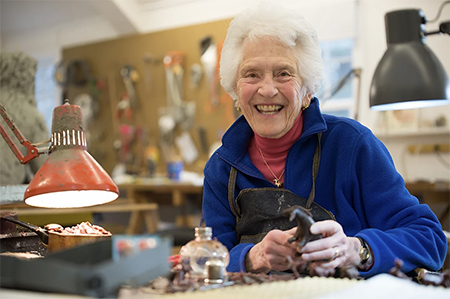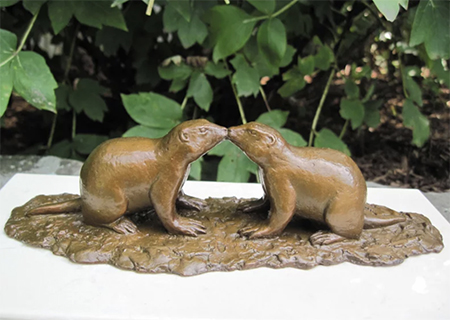Nancy Schön: Bold & Bronze
 Nancy Schön’s iconic Make Way for Ducklings sculpture.
Nancy Schön’s iconic Make Way for Ducklings sculpture. Photograph courtesy of Nancy Schön.
Bronze sculptor Nancy Schön, best known for her Make Way for Ducklings sculpture located in Boston’s Public Garden, says the best lesson she ever learned came from her father when she was a young girl.
“When everyone is going through one door, you find another door to go through,” says Schön of the advice her father gave her on earning a living as a woman. “That was the big lesson I learned and I have been a maverick in that sense.”
The lesson continues to shape her work today, when at the age of 91 she is equipped with an enthusiasm for her latest projects that indicate there’s no slowing down in sight for this sculptor of public art exhibited internationally.
As a 1952 graduate of the School of the Museum of Fine Arts in Boston, and the mother of four young children at the start of her career, Schön says the evolution of her work has been reflective of the stage of life she was in at the given time.
“I did a lot of small sculptures of mothers and children when my children were young,” she says. “I cast bigger things as they got older -- I couldn’t afford bronze until they got bigger.”
 Nancy Schön working in her studio.
Nancy Schön working in her studio.Photograph courtesy of Nancy Schön.
Her interest in animals, reflective in her best-known works, has always been with her. She recalls her household included fish, a rabbit, gerbils, cats and dogs.
Profound insight
However, what solidified the direction of centering her work on animals involved a “profound insight” she gained through observation when she first started doing public art. She noticed that people, regardless of age, looked at sculptures in parks casually and then went on their way until one day when she saw a sculpture of a child with a cat. Instead of walking past it, people stopped to pet and hug the cat -- they smiled at it. From that moment on she decided her sculptures had to be interactive and touched.
“I think that incident with the child was the beginning,” she says. “But I never thought my life would take the turn that it did.”
The “turn” to which Schön was referring occured in 1987 when she installed Make Way for Ducklings, which depicts the mother duck and her eight ducklings from the book of the same name by author Robert McCloskey. Later, in 1991, a copy of the same sculpture was installed in Moscow -- a gift from the former First Lady of the United States, Barbara Bush, to former First Lady of Russia, Raisa Gorbachev, as a gift to the children of the Soviet Union.
“The ducks were the big thing that got me going,” Schön says.
Tortoise and Hare
Another noteworthy sculpture, Tortoise and Hare is a piece by Schön that was installed at Boston’s Copley Square in 1995 to honor all of the runners of the Boston Marathon. It was inspired by the classic Aesop’s Fable, The Tortoise and the Hare.
 Friendship Maquette sculpture by Nancy Schön.
Friendship Maquette sculpture by Nancy Schön.Photograph courtesy of Nancy Schön.
“I decided it was important for me to do something to commemorate the Boston Marathon,” she says. “This was a metaphor for all of the runners that were running.”
This piece, and other works of Schön’s based on Aesop’s Fables, take on an even deeper meaning that centers around a question Schön ponders about humanity as a whole.
“The fact that we are still quoting this man who was a Greek slave 2,500 years ago -- does this tell us something?,” says Schön, who also holds a degree in sociology . “I have to question who we are.”
As for her Tortoise and Hare sculpture, Schön has had a relationship with the Boston Marathon since her youth when she used to hand out water to runners, so it is an event that has always been a part of her life.
“I love the Marathon and running has been a passion for me,” she says. “My daughters and grandchildren ran it.”
Prior to its home at Copley Square, a fitting location for the piece given it was the location of the finish line for the marathon at one time, the sculpture has also been on view at the Kennedy Center and Boston’s Symphony Hall.
“The best story that ever happened to one sculpture,” Schön says, referring to the journey Tortoise and Hare went on during the seven-year period she spent working to get it on permanent view at Copley Square.
Intuitive way of working
What has inspired Schön to use bronze over the years has to do with its longevity combined with her being a self-described classicist. It’s a material that she has always felt was special ever since she fell in love with Michaelangelo’s work at the age of ten.
“You know it’s forever -- it has a feeling of permanence,” Schön says. “I like the colors -- it sparkles in the sunlight and despite the fact that it’s a metal, it has a lot of warmth.”
Schön describes her process of making an armature for her large-scale sculptures before having them made into molds at a nearby foundry. Equipped with what she refers to as an intuitive way of working with her hands, she begins the process by using aluminum wire and plumbing pipes.
“They are like tinker toys -- so I can make all sorts of stick figures,” Schön says. “That’s where I start and then I add styrofoam and then I add clay.”
She uses the same foundry today that she has used since the 1990s, Sincere Metal Works in Amesbury, Massachusetts, despite them going through some ownership and name changes.
Busy as a bee
Schön, who now has eleven grandchildren and three great-grandchildren, remains busy as a bee working out of her studio located behind her home in West Newton, Massachusetts. The studio, where she has 900 square feet of workspace, was constructed by enlarging her garage.
“I get crazy if I don’t have a lot of work,” she says.
The process Schön says she enjoys most about her work is stepping up to the challenge.
“I love trying to figure things out,” she says. “It’s the challenge of saying, “yes”, I can do it and then doing it, but you have to figure it out since it’s not so easy.”
Another aspect of the creation process she enjoys is the research involved and how it impacts those viewing her work, something she has witnessed through their emotional responses and reactions.
“One of the things I hear all the time is, ‘your animals are so real, they talk to me and they are so alive’,” she says. “I think the reason they say that is because one of the things I do is spend a lot of time at the library -- I learn every animal’s different anatomy.”
Along with the pleasures involved with the research and creation of each piece of art, Schön shares that they also come with their share of challenges, between getting permits, the efforts of raising money to get them made, going in front of Boards, marketing efforts and more.
However, despite these challenges, it has been the research aspect that Schön credits for enabling her to continuously learn new things. She feels this has contributed to her longevity.
“I love learning all the time and I think that keeps me alive,” she says. “My mind is pretty sharp and my creative juices are really good.”
Resources:
Also in this Issue:
- Nancy Schön: Bold & Bronze
- Mutu’s Bronze Facade Commission on Display at the Met
- Élan Young: Coming Home to Copper
- Sculptor Chris Navarro: Adventures in Bronze and Beyond
- J. Anne Butler: Inspiration in Emotion
